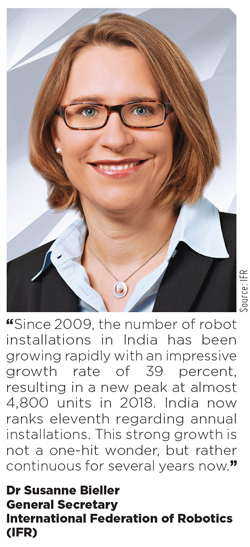PUSHING BOUNDARIES
Dr Susanne Bieller, General Secretary, International Federation of Robotics (IFR), in this interview with Soumi Mitra, Editor in Chief, MMI, sheds light on the changes she has been observing in the manufacturing sector’s acceptance of robotics over the years, the spurred interest in it due to Covid-19, India’s current position in the adoption of the technology and its promising prospects…
Mitra : Kindly tell us about the vision and objectives of IFR as well as your contribution to the organization.
Dr Bieller : IFR connects the world of robotics around the globe and acts as the voice of the global robotics industry. We aim at promoting and strengthening the robotics industry worldwide and at increasing public awareness about robotics technologies. Part of our mission is also to foster the collaboration between companies and academia around the globe.
In order to do so, IFR is compiling the annual statistics on the global robotics market, which is esteemed and often known as World Robotics. Furthermore, we publish positioning papers on the big megatrends impacting our industry, like cobots,
AI and digitization.
As General Secretary, I am responsible for coordinating the work of our different committees and bodies, and, in close collaboration with our President and Executive Board, for representing the IFR both towards international organizations like the OECD (Organisation for Economic Cooperation and Development) and UNIDO (United Nations Industrial Development Organization) and at events like conferences and trade fairs. Last but not least, I am also in charge of our PR activities. With the attention robotics has gained in the past years, this is an exciting and challenging task, which provides the huge opportunity to influence the public perception of the technology and the acceptance of robots in society. It is a very fascinating sector to work for!
Since you have been seeing the industry closely for a long time, what are the prominent changes that you have observed in terms of acceptance and deployment of robotics in the manufacturing sector?
When I started in robotics, robots always had to be hidden behind fences. They were well established in the Automotive sector. Next, we saw the rise of robotics in the Electronics industry, which requires robots quite different from those used for building cars. Then came the introduction of the so-called cobots, and robots suddenly could leave their cages and work alongside humans. This was accompanied with the public perception that robots are taking jobs away from humans. Thanks to PR work of the IFR and many other associations, a lot has changed since. The understanding rose that it is not either robots or human workers, but rather both or nothing: companies need to deploy robots and automation solutions to stay competitive and maintain jobs. Trade unions are increasingly supportive and welcome the deployment of robots. Nowadays, new sectors are increasingly using the technology, and new technological developments are backing this.
 Covid-19 has changed the way the manufacturing world operated. The pandemic and resulting worker health-and-safety requirements have spurred interest in robotics in the supply chain. How much, according to you, will the adoption rate for robotics and automation increase in the time to come?
Covid-19 has changed the way the manufacturing world operated. The pandemic and resulting worker health-and-safety requirements have spurred interest in robotics in the supply chain. How much, according to you, will the adoption rate for robotics and automation increase in the time to come?
It was indeed amazing to see how the pandemic has spurred the interest in robotics. The motivation to invest in technology is multifaceted: At the beginning of the pandemic, we saw production outages due to disruptions in global supply chains. Companies now review this and consider to re-shore the production of critical parts, which often requires automation to keep costs under control. Then companies faced issues to implement social distancing rules, so they investigate how robots can help to uphold production. We can observe now what we have already monitored in crisis situations before: companies using automation are more resilient and recover faster from exogenic shocks.
How fast and to what extend this will translate into business and higher adoption is certainly well linked to the recovery of the industry in general. We see an increased interest in robotics solutions around the globe, not only by the large players, but also by SMEs and by sectors that were hesitant to automate their production processes. At the end, the implementation of projects, and thus the adoption rate is strongly dependent on the availability of capital for the necessary investments. Equally important are the skills that need to be ready. First of all, for the integration process: combining process knowledge with the insight on robots, but in the long run, also for operation, maintenance and necessary adaptions to the manufacturing setup. We are facing a shortage of skilled workers today so in order not to limit the further adoption, we need to speed up skilling, up-skilling and re-skilling measures.
How much role does robotics play in Industry 4.0? Which are the other advanced technologies where you see robotics contributing?
The vision of Industry 4.0 is of a seamless automated process from order through to dispatch and delivery. Machines can communicate with each other as well as report on their own status, producing data that can be aggregated across multiple machines or an entire process. This data can be analyzed and used to anticipate bottlenecks in the production process as well as forecast when machines need servicing, saving costs in machine downtime which can run to millions of dollars per minute. The digitization of parts or the entire manufacturing process brings various advantages to manufacturers which, collectively, lead to significant productivity increases and cost savings. Robotics certainly are a core element of Industry 4.0 since they offer a huge versatility to either connect different machines on the shop floor, be used as a tool to manipulate objects, or simply handle and move parts or finished goods. Connecting smart robots to a Cyber-physical system on the manufacturing floor brings additional benefits like lower cost of quality, traceability, performance optimization through internal knowledge-bases, real-time and remote fault detection / solving as well as condition-based monitoring, maintenance and inspection, decreasing overall downtime and avoiding unexpected shut-downs.
In combination with AI technologies and improved sensors, robots will be enabled to sense and respond to their environment and positively impact our daily life.
Robotics will also play a major role in the workplace of the future. For instance, robots make work safer and less physically demanding. Robots already carry out a variety of dangerous tasks. New developments in collaborative robots and exoskeletons will reduce chronic health complaints associated with unergonomic tasks, particularly heavy lifting. They will also support manufacturing employees in decision making, through better information from machine performance data that can be analyzed for machine and process optimization.
In combination with AI technologies and improved sensors, robots will be enabled to sense and respond to their environment and positively impact our daily life.
Where do you think India stands in the adoption of the technology as compared to other developed nations?
India is one of the strongest growing economies among the Asian emerging markets. But due to low wages and insufficient infrastructure, using automation in the production process is not always the preferred option.
However, since 2009, the number of robot installations has been growing rapidly and - while the global results were quite moderate - India saw an impressive growth rate of 39 percent, resulting in a new peak at almost 4,800 units in 2018. India now ranks eleventh regarding annual installations. This strong growth is not a one-hit wonder, but rather continuous for several years now, as the annual compound growth rate of 20 percent between 2013 and 2018 shows.
Since the adoption of robots has only kicked off in the recent years, India still needs to make up the leeway. To be able to better compare the adoption rate of robots among countries differing in size and share of manufacturing, IFR calculates the value called robot density, which is the number of industrial robots in operation per 10,000 employees in the manufacturing sector. The global average across all countries monitored by IFR is currently at 99. Frontrunners Singapore and South Korea are at 831 and 774, respectively. India currently has a robot density of 4, which still leaves quite some room for improvements – prospects for India are promising.
The Automotive industry is the major end-user of the industrial robotics market in India. Could you please provide us with a global perspective?
The other two major customers of robots in India are the Rubber and Plastics industry and the Metal industry, each with a 9 percent share. The Automotive industry is by far the largest customer industry, with a share of 44 percent of total installations, but growth driver in 2018 was the General industry comprising of the Rubber and Plastics industry (9%), the Metal industry (9%) and the Electrical/Electronics industry (5%), increasing by 28 percent. We thus see that robot use in the non-automotive manufacturing is catching up with the Automotive sector. The two main applications in India, which make up 86 percent of the market are accordingly welding and handling operations.
On a global scale, Automotive (30%) and Electrical/Electronics (25%) are the two major customer industries, followed by the Metal industry (10%). Plastic and chemical products globally only account for 5 percent of installations.
According to UK-based data analytics firm GlobalData, adoption of robots to treat Covid-19 patients is expected to grow in India. Will the healthcare industry become the major end-user of the Industrial Robotics market in India during and post pandemic?
Within the robotics market, we distinguish between industrial robots and (professional) service robots. Robots used in healthcare and medical applications belong to the second category. Since the outbreak of the pandemic, we have indeed seen a vast number and different types of service robots used in hospitals and care facilities. To give just a few examples from around the globe: we have seen telepresence robots enabling contactless communication between patients and medical staff, mobile robots used for scanning the body temperature of people strolling the corridors of hospitals and other care facilities, robots used for disinfection and such supporting hospital logistics – bringing food and consumables into isolation wards. Humanoids are naturally not the best solution for this.
We see an increased interest in robotics solutions around the globe, not only by the large players, but also by SMEs and by sectors that were hesitant to automate their production processes.
Moreover, industrial robots are also used to automate lab tasks to be able to upscale testing against Covid-19 and even to automate the process to take throat swabs.
The Robotics industry has taken the pandemic as an opportunity to showcase its creativity, and the flexibility and adaptability of robots to quickly come up with diverse solutions to the problems we suddenly faced in the pandemic.
Source : IFR
 |
SOUMI MITRA Editor-in-Chief Modern Manufacturing India soumi.mitra@magicwandmedia.in |





 Facebook
Facebook.png) Twitter
Twitter Linkedin
Linkedin Subscribe
Subscribe